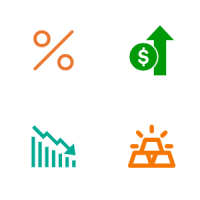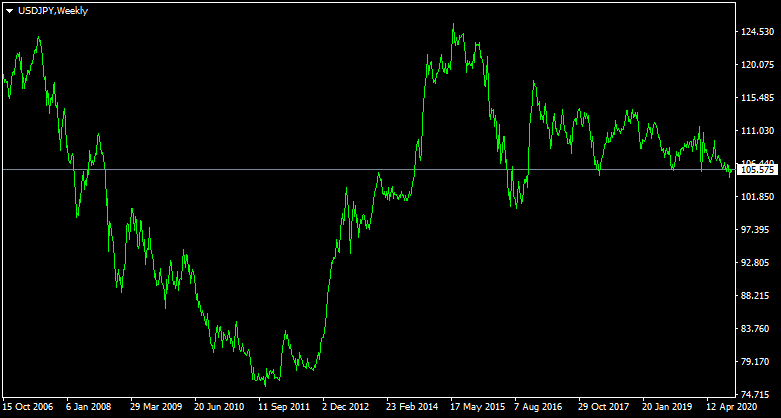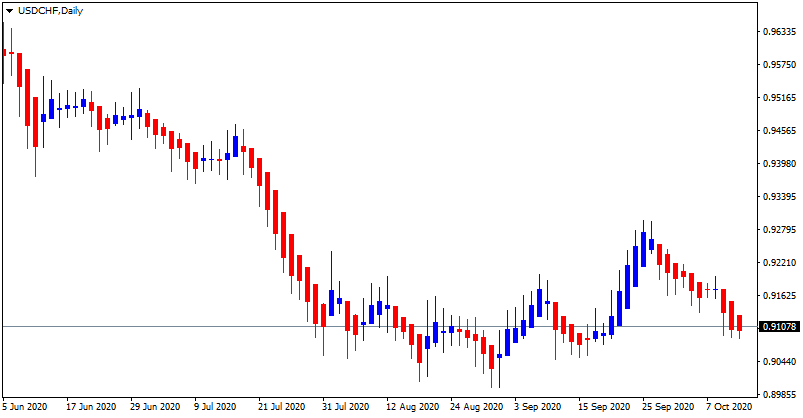Table of content
Inflation is essentially defined as a sustained increase in the general price levels. It goes without saying that the absolute majority of currencies in the world experience different degrees of inflation. The average CPI for most major economies is around 2% to 3% range. While inflation in the emerging market economies can be considerably higher.
Despite some level of inflation is the norm with nearly all of the currencies, it is important to point out that from there are indeed some countries that experienced or are still experiencing the prolonged period of deflation.
This term is defined as a sustained fall in the overall price levels. Obviously, from time to time some grocery stores or other types of shops might put certain items at the sale, however, this is not the case of deflation. Economists and financial commentators are using this term only in cases when there is a sustained fall in prices.
It is not a secret that deflation is very unpopular even with central banks. In fact, policymakers in those institutions are using a number of monetary policy tools to make sure that the economy avoids a prolonged period of deflation. Those tools might include near-zero interest rates and quantitative easing programs. In addition to that, some central banks have gone even as far as to adopt negative interest rates.
It goes without saying that those measures tend to weaken the currency in question in the short term. However, one curious thing about deflation is that if this process persists for an extended period of time, it can be a significant contributor to the strength of the currency. One of the main reasons here is the fact that by deflation, the currency gains more buying power over time, something which gives it a significant advantage over its peers.
Therefore, in some cases, opening a long position with those currencies can be profitable for traders. However, the problem here is that those currencies usually have very low interest rates, consequently, it is highly likely that the market participants might face significant amounts of rollover charges. So in order to avoid those types of expenses, it might be a good option for those traders to trade with swap-free accounts.
Finally, it is important to mention that deflation does not always guarantee a current strength in the long term if the currency is managed by a pro-active central bank. The reality of the matter is that over time, the policymakers might make more and more aggressive easing decisions, which might hurt the value of its currency significantly. Therefore, it is always helpful to consider all those factors before making any trading decisions.
Why do Central Banks Hate Deflation?
At this point, many people might ask a very logical question: Why do central banks are so concerned about deflation? Are not falling prices beneficial for the consumer?
Well, the official explanation coming out of the majority of the central banks is that it is much easier to tackle and remedy a high inflation rate than deflation. For example, if in a given economy, the consumer price index, also known as CPI rises to 4%, then the policymakers can simply raise rates repeatedly until the economy cools down and the inflation rate returns back to more reasonable levels.
On the other hand, if the CPI drops all the way down to -2%, then the central bank can not simply cut rates to -3% and solve this problem with this decision. The obvious problem here is that the policymakers can not simply enforce the negative interest rates because of two main reasons.
Firstly, it is essential to mention that it is very difficult to imagine the scenario where the commercial banks will be willing to issue loans at negative rates. This means that they essentially have to pay interest to their customers for borrowing money, instead of receiving any income. Obviously, this would lead to massive losses for the banking sector, hence the impracticality of such a policy.
It is also important to point out that the majority of savers would not be happy with just paying the money to the bank for the privilege of depositing money with them, instead of receiving any interest. Consequently, if the commercial banks impose negative rates on all of their savings accounts, then it is highly likely that customers will simply switch to their competitors, where they do not have to pay those charges. Or alternatively, customers might decide to withdraw the money and store their savings in cash, where they do not have to pay interest.
This means that 0% is the lowest interest rate central banks can enforce effectively. Therefore, if the economy falls deeply into deflation, it can become quite difficult to lift the economy out of it. So, this is a valid argument, and realistically describes the problems deflation produces for central bankers.
Other Problems Caused by Deflation
At this point, it is important to note that there are also other practical problems produced by deflation. The fact of the matter is that the majority of developed countries have built a huge debt pile over the decades. For example, the US national debt has already exceeded $26 trillion. There are also many European and Asian countries with massive amounts of debt.
Now, servicing and repaying all those debts is already a significant concern for the governments of those countries. However, the fact of the matter is that deflation can make the situation much worse. Here it is important to remember that the deflation tends to increase the buying power of the currency in question. This means that the purchasing power of all of those debts increases as well. Consequently, this development will make those liabilities much larger in real terms. As a result, a prolonged period of deflation can eventually lead to a sovereign debt crisis.

For example, let us suppose that the United States were to experience a 3% deflation for a year and maintained its national debt unchanged for this period. As a result, in nominal terms, the size of the debt still will be at $26 trillion. However, if we measure this change in constant dollars, then the total value of those liabilities will rise to $26.78 trillion. This is because in this scenario, $26 trillion today will have the same buying power as $26.78 did a year ago.
Therefore, as we can see here a 3% deflation will add $780 billion in real terms to the US national debt. It goes without saying that this can be very damaging for the US public finances.
On the other hand, if the inflation rate in the US will be 3%, as the long term average, then in constant dollars, the debt pile will shrink to $25.24 trillion. This is still a very large sum, however, it is also considerably less than $26 trillion.
Obviously, this devaluation of debt will be even larger with higher inflation rates. However, the US Federal Reserve is committed to maintaining the safe-haven status for USD, so allowing inflation to reach double digits would be counterproductive. Instead, since the creation of the US Federal Reserve system, the long term average inflation rate is near 3%.
This allows the US dollar to retain its global reserve currency status. After all, it is important to remember that in many developing countries there are cases of massive devaluations and double-digit inflation rates. Consequently, knowing that one can retain 97% of its purchasing power over 1 year, can seem like a good deal to many people in those countries. In addition to that, those individuals have an option to invest those amounts to offset costs due to inflation.
Here it is also important to mention that deflation does not only create problems for governments, it can also become a major issue for homeowners. It is indeed true that there are some people who are buying homes with cash. However, the majority of consumers simply can not afford to do so. Consequently, they buy homes with mortgage loans.
Obviously, unlike the government, individual consumers can not borrow trillions of dollars. However, many of those individuals do have mortgage balances in excess of $100,000. So 3% deflation, means that in constant dollars a debt pile of an individual with a $100,000 mortgage will rise to $103,000 in a single year.
If the deflation persists over the years, this can make the debt burden, even more, heavier for many consumers. The result of this development will be an increasing number of defaults and foreclosures, leading to another financial crisis.
It is also worth noting that deflation will also increase the real value of other types of loans, such as student loans, consumer loans, car loans, as well as credit cards. So as we can see a prolonged period of deflation can have a very damaging effect on the economy.
Arguments for Deflation
There are indeed some financial experts and economists, who argue that deflation is good for consumers and it does not necessarily mean that this deflationary process will be damaging for the economy. In order to reinforce their argument, they mention the prolonged deflationary period in US history in the aftermath of the civil war.
It goes without saying that waging a prolonged war always requires a massive amount of expenditure. Therefore, during the civil war, the US started issuing paper notes, leading to considerable inflation. However, after the war ended in 1865, there was a period of deflation, with prices slowly but surely returning back to the pre-war levels. Despite this process, the US still managed to maintain a decent amount of economic growth throughout this period.
So what those financial experts and economists are arguing is that since the US managed to maintain solid economic growth even in times of deflation, then it is possible to do it again, during the 21st century.
Here it is important to note that as things stand, nowadays it is impossible to achieve this. The reason for this is very simple: nowadays the amount of debt for the government and citizens is much larger than back during the 19th century. Not only the US national debt surpassed $26 trillion, but according to the US debt clock website, the average personal debt for US citizens is above $62,800.
This includes mortgages, student loans, car loans, credit cards, and all other types of personal debt. It is also worth noting that since $62,800 is just an average figure, the debt pile of millions of citizens can be considerably higher than this number. Therefore, deflation in this case can be very damaging to the economy. It can easily lead to a large number of defaults and a sharp recession.
For the deflation not to have such a devastating effect on the economy, governments and individuals in developed countries should reduce the overall size of their debts considerably. However, obviously, this process will take many years to bring results. It is also important to point out that the majority of highly indebted countries so far have shown no intention to balance their budgets and pay down their debts.
Therefore, having a moderate amount of inflation 2% to 3% can be the best interest of the governments of developing countries as well as for a significant portion of their citizens.
How does Deflation Affect Currencies?
One of the most famous cases of prolonged inflation is that of the Japanese economy. From the late 1990s until 2012, the Japanese CPI was not always in the negative territory, but this happened very frequently and many economists considered Japan to be in a deflationary spiral.
The inflation data itself suggests that periods of deflation have been followed by periods of low inflation. So in the end, those two periods canceled out each other and the overall price levels remained mostly unchanged.
The Bank of Japan responded by cutting rates dramatically, reducing all the way down to 0.25%. When this failed to produce desirable results, the policymakers went further, cutting rates to -0.1%, accompanied by massive amounts of quantitative easing. This eventually bought some results, with the average CPI reaching 2% after 2012.
Despite all of those efforts, since 2016, the Japanese policymakers struggled to maintain the CPI at 2% target. In addition to that after the outbreak of the COVID-19 pandemic, the Japanese inflation rates fell sharply, at one point in May 2020, even reaching 0%. Since then the CPI rate slightly recovered, but by September 2020 it was at 0.2%, still very much close to deflationary territory.
So how did those developments affect the exchange rates of the Japanese yen? Well, in order to respond to this question, let us take a look at this weekly USD/JPY chart:

As we can see from the above diagram, the USD/JPY was in a solid downward trend from Summer 2007 until the late Autumn 2012. During this period, the exchange rate of this pair has fallen from 123 all the way down to 76. In fact, in response to the sharp appreciation of the Japanese yen, the Bank of Japan went as far as to announce 75 level as a floor for the USD/JPY exchange rate, promising to intervene if the pair tried to break below this mark.
However, as we can observe from the diagram, as the Japanese economy started to get out of deflation, the Japanese yen started to depreciate considerably. In fact, from 2012 until 2015, the USD/JPY has risen from 76 to all the way up to 126 level. This means that in less than 3 years time, the US dollar has erased all of its losses against the Japanese yen.
However, as the Japanese inflation rate began to decline, the USD/JPY once more began its long term decline. As a result, from 2015 until September 2020, the pair fell from 125 to below 106 level. So as we can see here, the Japanese yen has regained a significant portion of its recent losses.
Why Stagnant Price Levels Can Strengthen Currency?
So far as we have seen from the case of USD/JPY, once more confirms that near-zero inflation can, in the long term, be beneficial for the currency in question. At this stage, the obvious question is: why is this the case?
This seems quite strange since currencies with such low inflation rates usually have their interest rates at zero or even in the negative territory. This means that if traders open and keep long positions overnight, then they have to pay interest payments to brokers. This is also referred to as a rollover or swap. It goes without saying that this discourages traders from opening positions in favor of those currencies. In addition to that those currencies are also very unattractive for depositors, since returns on savings accounts or certificates of deposit in those currencies are very low, in most cases close to zero.

So considering all of those disadvantages, why currencies with zero or negative inflation rates tend to appreciate in the long term against most of their peers? Well, one logical explanation for this phenomenon is in the purchasing power parity theory, also known as PPP.
The purchasing power parity essentially represents the exchange rate at which the average prices of goods and services between the two countries will be equalized. According to the PPP theory, if the currency trades below this level, then it is considered to be undervalued and in the long term, will appreciate against its peers, until it reaches the PPP equilibrium.
The general explanation for this theory is that when the exchange rate of the individual currency is below PPP, it makes the prices of goods and services in the given country much cheaper than abroad. It goes without saying that everything else being equal, this increases the demand for those products from abroad. After all, foreign importers are always interested to save money on their raw materials and other products. So this raises the demand for the currency in question and leads to its long term appreciation.
Now, one thing to keep in mind here is that when the currency in one country has its own price levels mostly unchanged over years, it tends to give it a significant advantage over its peers. This is because as products and services in other countries become more expansive, the prices in the country with no inflation remain the same. As a result, the prices of goods and services in this nation become cheaper than the rest of the world.
The effect is the same as in the previous case: cheaper products attract high demand, resulting in the long term appreciation of the currency. In addition to that, it is worth noting this process also pushes the PPP level in favor of the currency which has lower inflation rates compared to its peers.
Returning to our previous example of USD/JPY. According to the British financial magazine the Economist, back in 2000, the purchasing power parity level of USD/JPY was near 117. However, since the inflation rates in Japan were lower than in the United States, by 2020 PPP is now near 68.
We can actually see this reflected in the actual exchange rates of the USD/JPY pair as well. By the end of 2001, as a result of the strength of the US dollar, the pair had climbed all the way up to 134 level. Here it is important to point out that even during the USD/JPY rally from 2012 to 2015, the US dollar has never approached the 134 level. In fact, the highest level it has reached during this period was close to 126. So as we can see here, with this pair the highs are getting lower in the long term.
Other Currencies Experiencing Deflation
As noted before, the Japanese yen is not the only currency in the world that has experienced a prolonged period of deflation and stagnant price levels. Since the 2008 Financial Crisis, the Swiss Franc became yet another currency that has been affected by those types of dynamics. In fact, from 2008 until 2020, the price levels in Switzerland remained mostly unchanged.
It is not surprising that the Swiss National Bank has responded to those developments with some decisive steps. The Swiss policymakers firstly reduced rates to zero, however, when this has failed to produce the desired results, they have decided to lower rates further, all the way down to -0.75%.
This had very little effect on the Swiss inflation rate. Yet, those decisions have made the banking in the Swiss commercial banks much less appealing, as they have started charging interest rates on deposits above 250,000 CHF.
This was a reasonable approach since if Swiss banks started charging interest on all deposits, this most likely would have led to massive withdrawals from the Swiss banking sectors. So this was some type of compromise so that those financial institutions could be able to retain most of their clients and their deposits.
The surprising thing about this is that those decisions by Swiss policymakers did very little to weaken CHF. In order to observe the effects of such policy we can take a look at this USD/CHF Heiken Ashi chart:

As we can see from the above image, at the beginning of June 2020, the USD/CHF pair was trading close to 0.96 level. During the two subsequent months, the pair suffered some notable losses, eventually dropping all the way down to 0.90 to 0.92 range. The paid did try to break out above this range in September. However, as we can observe from the above diagram, the attempt simply failed and the USD/CHF pair has simply resumed its downward trend.
It is helpful to remember here that back in 2000, the USD/CHF pair was trading within 1.65 to 1.80 range. So, obviously, the long term decline of the pair is quite apparent.
One logical explanation for this development is the fact that just like in the previous case, the lower inflation rates in Switzerland has given a significant advantage to the Swiss franc, pushing the PPP levels in favor of the currency.
In fact, according to the Economist, back in 2000, the purchasing power parity level for USD/CHF was at 1.70. By 2020, the PPP level is now at 1.14. It goes without saying that such a large amount of change represents a major shift in the exchange rate dynamics of USD/CHF.
Obviously, the USD/CHF is not the only currency pair that has been affected by the strenght of the Swiss franc. Another obvious example of this is the EUR/CHF currency pair.
The fact of the matter is that, back in 2006, the pair was trading near 1.55 level. Now at that time, the yields favored the Euro, since the European Central Bank, also known as ECB, raised rates all the way up to the 4.75% mark. As a result, the EUR has made some notable gains against CHF, with the pair rising all the way up to 1.68 level during 2007.
However, confronted with the 2008 Financial Crisis, the European Central Bank has decided to reverse the policy in order to stimulate the economy, eventually cutting rates to 1% and after some years reducing them further to 0%. It is not surprising then that after 2008, the Swiss franc has appreciated steadily against the single currency. This steady appreciation of the Swiss currency has led to the Swiss National Bank stepping in to arrest the strengthening of the CHF.
In 2011, the policymakers at Swiss National Bank announced that they would be setting a floor for EUR/CHF rate at 1.20. The currency pair was free to go above this floor, but if the pair tried to break below this target, the SNB would intervene to weaken CHF.
This policy remained in place for more than 3 years. However, in January 2015, the floor collapsed, as the SNB has abandoned the policy in the wake of quantitative easing by the European Central Bank. As we can see from the chart, since then the EUR/CHF continued with its downward trend. By October 2020, the pair trades close to 1.07 level.
One of the reasons for this strenght of the Swiss currency is the fact, that the average inflation rates in Switzerland are much lower than in the United States and in the Eurozone. As a matter of fact, since 2008 the price levels remained relatively flat in Switzerland. Consequently, this makes CHF as a good store of value, since people saving money in this currency can retain their purchasing power over extended periods of time.
Influence of Deflation on Currencies – Key Takeaways
- Deflation represents a fall in general price levels in a given country. Japan and Switzerland are two countries that have recently experienced a prolonged period of deflation as well as stagnant price levels.
- In the short term, deflation tends to lead to currency depreciation. The main reason for this is that central banks usually respond by cutting interest rates and even announcing quantitative easing programs in order to stimulate the economy. This tends to make the currency in question less attractive for investors and traders.
- Surprisingly, in the long term, currencies tend to benefit from stagnant price levels. One logical explanation for this is in the purchasing power theory. As PPP theory suggests, currencies with lower inflation rates tend to appreciate against the ones with higher inflation levels, as over time the average prices of goods and services become cheaper and consequently much more attractive for foreign importers.



